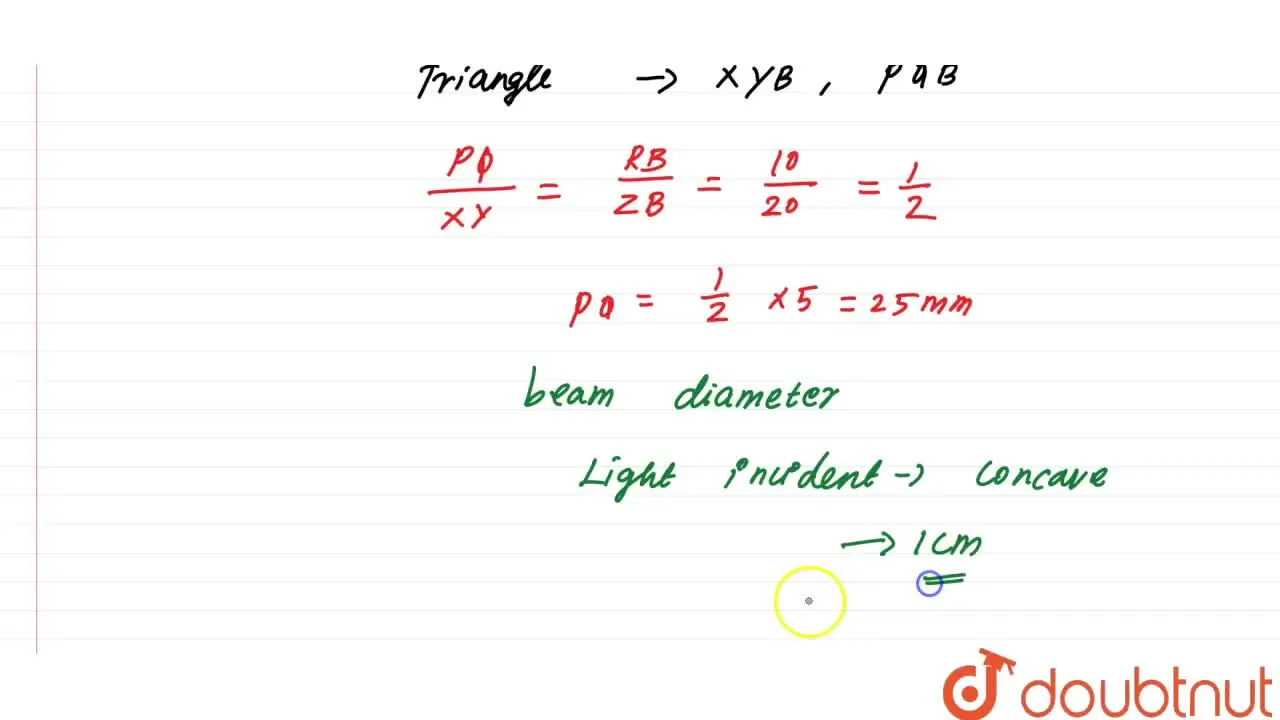A convex lens of focal length 20 cm and a concave lens of focal length 10 cm are placed 10 cm apart with their principal axes coinciding. A beam of light travelling parallel to the principal axis and having a beam diameter 5.0 mm, is incident on the combination. Show that the emergent beam is parallel to the incident one. Find the beam diameter of the emergent beam. Solution in Tamil
The correct Answer is:A, B, C, D
Let the parallel beam is first incident on convex lens.
d=diameter of the beam =5mm
Now, the image due to the convex lens should be formed on its focus (point B).
so for the concave lens,
u=+10 cm (since, the virtual object is on the right of concave lens)
f=−10cm
So,1v−1u=1f
→1v=1−10+1+10=0
→v=0
So, the emergent beam becomes parallel after refraction in concave lens.
As shown from the triangle XYB and
PQ=12×5=2.5mm
(PQ)/(XY)=(RB)/(ZB)=10/20=1/2
So, the beam diameter becomes 2.5 mm. Similarly it can proved that if the light is incident of the concave side, the beam diameter will be 1 cm.
Related Playlists
Similar Questions
If the light moving in a straight line bends by a small but fixed angle it may be a case of
03:26View SolutionThe electric field in a region is given by →E=35E0→i+45E0→j with E0=2.0×103NC−1. Find the flux of this field through a recatngular surface of area 0.2m2 parallel to the y-z plane.
02:34View SolutionFind the range of frequency of light that is visible to an average human being (400nm<λ<700nm)
01:36View SolutionA parallel beam of rays is incident on a convergent lens with a focal length of 40cm. Where a divergent lens with a focal length of 15cm be placed for the beam of rays to remain parallel after passing through the two lenses.
04:36View SolutionA convex lens of focal length 20cm and a concave lens of focal length f are mounted coaxially 5cm apart. Parallel beam of light incident on the convex lens emerges from the concave lens as a parallel beam. Then, f in cm is
02:23View SolutionA convex lens of focal length 1.0m and a concave lens of focal length9.25m are 0.75m apart. A parallel beam of light is incident on the convex lens. The beam emerging after refraction from both lenses is
View SolutionA convex lens of focal length 20 cm and a convex mirror of focal length 10 cm are placed co-axially 50 cm apart from each other. An incident beam parallel to its principal axis is incideent on the convex lens. Locate the position of final image formed due to the combination.
06:40View SolutionA paralel beam of light incident on a concave lens of focal length 10 cm emerges as a parallel beam from a convex lens placed coaxially, the distance between the lenses being 10 cm. The focal length of the convex lens in cm is
02:13View SolutionA convex lens of focal length 30 cm and a concave lens of 10 cm focal length are placed so as to have the same axis. If a parallel beam of light falling on convex lens leaves concave lens as a parallel beam, then the distance between two lenses will be
01:30View SolutionA converging lens of focal length 10cm and a diverging lens of focal length 5cm are placed 5cm apart with their principle axes coinciding. A beam of light travelling parallel to the incident one. Find the beam diameter of the emergent beam is parallel to the incident one. Find the beam diamter of the emergent beam. Alos find out the ratio fo emergent and incident intensities.
View SolutionA converging beam of light is incident on a concave lens of focal length 20 cm. In the absence of the lens, the beam converges at a point 10 m behind the lens. Find where the beam will converge/diverge after refraction.
05:16View SolutionA convex lens of focal length 100 cm and a concave lens of focal length 10 cm are placed coaxialiy at a separation of 90 cm. If a parallel beam of light is incident on convex lens, then after passing through the two lenses the beam
04:11View SolutionBeam expander Assume that a parallel beam is incident on two convex lens of focal length 20cm and 40cm. The beam has a diameter of 2cm. What should be the distance between them so that the final beam emerges parallel to the principal axis( Fig. 34-46) ?
00:57View SolutionA convex lens of focal length 20 cm and a convex mirror of focal length 10 cm are placed co-axially 50 cm apart from each other. An incident beam parallel to its principal axis is incideent on the convex lens. Locate the position of final image formed due to the combination.
03:37View SolutionA parallel beam of rays is incident on a convergent lens with a focal length of 40cm. Where should a divergent lens with a focal length of 15cm be placed for the beam of rays to remain parallel after passing through the two lenses.
03:31View SolutionA convex lens of focal length 1.0m and a concave lens of focal length 0.25m are 0.75m apart. A parallel beam of light is incident on the convex lens. The beam emerging after refraction from both lenses is
01:44View Solution


